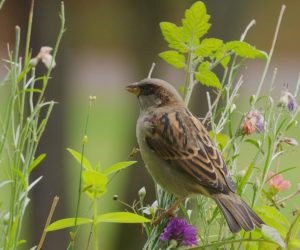This content was originally published by the Longmont Observer and is licensed under a Creative Commons license.
The English house sparrow is not a native North American species. The story of how it came to the United States is an interesting one. The house sparrow was first introduced in 1851 by a man named Nicholas Pike who bought 100 birds from England and released them to control the linden moth. Another large release occurred in the 1870s by a group called the American Acclimatization Society. This group wanted to bring to America every bird species mentioned by Shakespeare. Some of their introductions were not successful, but other notable successful releases were the starling and the rock dove, or pigeon. Several other releases occurred in San Francisco and Salt Lake City and within 50 years, the house sparrow could be found throughout the United States.
Originally a migratory species from Eurasia and north Africa, the house sparrow has been so successful living alongside humans that now it rarely migrates. Initially, the house sparrow was able to survive in cities because horse droppings contained many seeds. Today, they can be found at bird feeders, at fast food restaurants looking for handouts, and even picking insects off of car grills. The diet of the house sparrow is primarily made up of seeds, but it will eat insects during the summer, catching them in the air. As already mentioned, the house sparrow has also adapted to eat crumbs of human food. They have been known to steal food from robins and to pierce flowers to get at the nectar.
House sparrows usually nest in some kind of hole and can often be found nesting behind signs, rain gutters, nesting boxes, or nests of other birds. An aggressive bird, the house sparrow may kick other birds such as purple martins, eastern bluebirds, and tree swallows. House sparrows will usually only defend a small territory around their nest, with males only attacking other males and females only attacking other females. One study reported up to 70 different species of birds being attacked by house sparrows at nest sites.
House sparrows are a monogamous species and up to 60% of pairs remain together during the breeding season. Females tend to prefer males that have larger black bibs over those with smaller bibs. Nests are built by both parents and consists of grasses and weeds, twigs, and trash. Often the nest is lined with feathers. The female will lay 3-6 eggs which both parents incubate, although they can lay up to eight eggs. Eggs hatch after 10-14 days. Both parents are involved in feeding the young and the young will leave the nest at about two weeks after hatching. House sparrows can raise 2-3 broods per year.
House sparrows are a social species, often occurring in flocks. When in a flock, house sparrows have a pecking order. Typically, males with the largest amount of black on their chest are the most dominant birds. Males are dominant in the flock in the fall and winter, with females taking over dominance in the spring and summer. When on the ground, the house sparrow hops along rather than walking. House sparrows like to take dust baths, throwing dust over themselves just like they do with water.
Male sparrows have a grey head, a black patch or bib on their chest, white cheek patches, and a reddish-brown neck. When they are breeding, males have a black bill; otherwise, the bill is brown with yellow at the base.

Females are a buffy brown color with greyish-brown chests, a dark line behind the eye, and a back prominently striped with buff, brown, and black. Because house sparrows are not related to other North American sparrows, their body outlines differ somewhat. House sparrows have a chunkier body, fuller chest, a larger head, and a shorter tail and beak than most North American sparrows. They are 6-7 inches long. The oldest recorded house sparrow was 13 years and four months old.
The most common sound the house sparrow makes is a chirrup or cheep often described as monotonous. House sparrows also have different calls for breeding, danger, and territorial interactions. While males use the chatter call with other males only, females tend to use this call for female intruders to their territory and to their mates. Most often, house sparrows will sing or call near their nest site.
House sparrows should be easy to find as they appear to have little fear of humans. During the breeding season, you can observe them flying out of nests near signs and light fixtures. They are also easy to spot at backyard bird feeders and parking lots of fast food restaurants. Because they are so common, we tend to overlook them. The next time you are out and about, take notice of these little birds.


